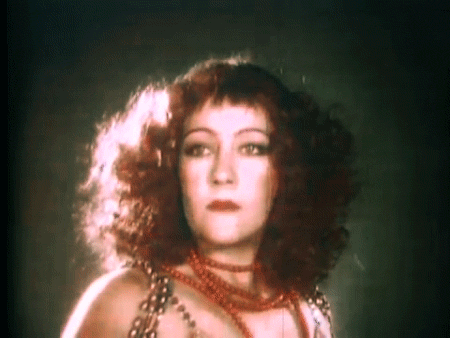 |
| Clara strides towards the New Year! |
+8.jpg) |
| Neil Hamilton and Colleen Moore |
This has been Colleen Moore’s year as she re-emerged on screen to blow us away with her intelligence, wit and sheer verve. Moore’s enduring impact was demonstrated no better than in the LFF screening of the recently re-discovered Why be Good – complete with the original Vitaphone soundtrack.
The Warner Archives DVD has also allowed my teenage daughter to find a new silent heroine!
+victory.jpg) |
| Si vis pacem, para bellum? |
A special night at the Southbank's Queen Elizabeth Hall with the BFI’s restoration being accompanied by a magnificently-moving new score from Simon Dobson performed by the Band of Her Majesty’s Royal Marines – a 24 piece ensemble in memory of the 24 bandsmen who perished on HMS Monmouth at Coronel.
Walter Summers’ painstaking reconstruction of these two key engagements from the Great War is all the more impressive as he used real sailors and ships – there were no model shots – a tribute to naval and creative discipline.
+light+5.jpg) |
| Harriet Bosse and Victor Sjöström |
The Sons of Ingmar is not digitised and can only be viewed when double-projected in cinema. This was a rare chance to view this important Victor Sjöström film and it proved to be deftly made and genuinely moving – worth the effort of finding a car parking space in Cambridge!
It was also good to finally see personal favourite dancer-actress Jenny Hasselqvist in Sjöström’s Vem Dömer (1922) – but why are so many of these films not on DVD?!
 |
| Mind your hats! |
Wilton’s wins my new venue discovery of the year award – an Eighteenth Century music hall on the fringes of the City that has great atmosphere and a bar too! The Hall was taken over by the Lucky Dog Picture House for a programme of comedy capers accompanied by the magic house band. We had Charlie in The Adventurer, Harold Lloyd in Never Weaken, Felix the Cat in Hollywood, George Méliès with four heads and Buster Keaton in Sherlock Jnr (1924).
 |
| Variety |
Another hugely enjoyable anthology evening, this time aimed at recreating the experience of a night at the cinema in the year that war broke out. The films on view were mostly British and ranged from clips showing the troops in Egypt to the unreal sight of German troops on bicycles after their rapid invasion of Belgium. It captured the “over by Christmas” spirit but the Empire wasn’t as strong as we thought… The picture houses went on to help maintain morale through the ensuing years of unrelenting sacrifice.
+stop.png) |
| Benita Hulme rouses the rabble |
It was good to see the BFI Player hosting some interesting British silent science fiction, from Maurice Elvey’s late silent-period High Treason to the very first domestic feature, A Message from Mars. I always like peering beyond the actors to the street settings and it was fascinating to see Trafalgar Square, the Mall and Edwardian fire engines tearing through pre-Great War London.
 |
| The Electric Cinema |
I’d kicked myself for missing the original performance from Lola Perrin – winner of Silent London’s poll way back in 2011 – and wasn’t going to pass up the opportunity again. Ms Perrin’s accompaniment was as unrelenting as the wind and melded so well with Victor Sjöström’s tale of life and death at the extremes...
The venue was also superb and if you’ve never experienced the plush, leather-seated living room comforts of the Electric Cinema I urge you to add it to your New Year’s resolutions – this is how all cinema should be!
 |
| The auditorium awaits... |
A grand evening with Timothy Brock conducting the BBC Symphony Orchestra as they played along to the early works of Mr C Chaplin of Walworth. Call me an inverted snob but the orchestrated set pieces at the Royal Festival Hall sometimes seem more for the “concert crowd” than the cineaste whereas the Barbican feels more focused on the film. There was barely a set of red braces in sight as the beards and cloche hat brigade laughed their heads off at The Immigrant, Kid Auto Races and Shoulder Arms.
Neil Brand’s sprint to the stage to take his un-expected bow for Easy Street’s new score epitomised the unaffected joy of the event.
+scream.jpg) |
| The Music Lovers (2013) |
An unexpected delight at an unusual venue where I was probably the only non-Italian speaker and the only non-Armani wearing attendee…
We were treated to five short films from the golden age of Turin Cinema all accompanied by the music of Mauro and Roberto Agagliate. Matteo Bernardini hosted the evening which was topped off by a showing of his silent short The Music Lovers (2013).
+Showgirl.png) |
| Naughty, bawdy, gaudy, sporty Friedrichstrasse… |
Director Walter Ruttmann’s rhythmic city symphony was brought to life by swinging syncopation from Stephen Horne on piano, accordion and flute along with Martin Pine on drums and vibraphone. This was “lean-forward” silent media with an urban-edge that peeled away the years: for 65 minutes we were all Berliners (at least the 1927 variety...).
More proof, if it were ever needed, that silent film is best viewed with live music. The media may be old but the improvised response from expert musicians helps transmit an edge of uncertainty to an audience experiencing something genuinely new.
 |
| Gloria is Stage Struck! |

+colour.png)









No comments:
Post a Comment